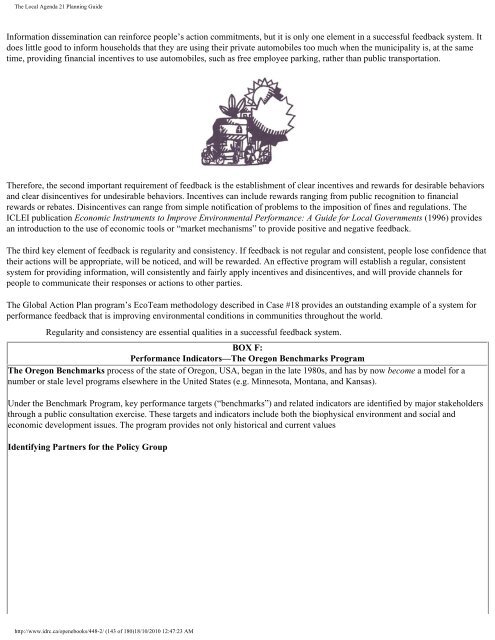The Local Agenda 21 Planning Guide - Democrats Against UN ...
The Local Agenda 21 Planning Guide - Democrats Against UN ...
The Local Agenda 21 Planning Guide - Democrats Against UN ...
You also want an ePaper? Increase the reach of your titles
YUMPU automatically turns print PDFs into web optimized ePapers that Google loves.
<strong>The</strong> <strong>Local</strong> <strong>Agenda</strong> <strong>21</strong> <strong>Planning</strong> <strong>Guide</strong><br />
Information dissemination can reinforce people’s action commitments, but it is only one element in a successful feedback system. It<br />
does little good to inform households that they are using their private automobiles too much when the municipality is, at the same<br />
time, providing financial incentives to use automobiles, such as free employee parking, rather than public transportation.<br />
<strong>The</strong>refore, the second important requirement of feedback is the establishment of clear incentives and rewards for desirable behaviors<br />
and clear disincentives for undesirable behaviors. Incentives can include rewards ranging from public recognition to financial<br />
rewards or rebates. Disincentives can range from simple notification of problems to the imposition of fines and regulations. <strong>The</strong><br />
ICLEI publication Economic Instruments to Improve Environmental Performance: A <strong>Guide</strong> for <strong>Local</strong> Governments (1996) provides<br />
an introduction to the use of economic tools or “market mechanisms” to provide positive and negative feedback.<br />
<strong>The</strong> third key element of feedback is regularity and consistency. If feedback is not regular and consistent, people lose confidence that<br />
their actions will be appropriate, will be noticed, and will be rewarded. An effective program will establish a regular, consistent<br />
system for providing information, will consistently and fairly apply incentives and disincentives, and will provide channels for<br />
people to communicate their responses or actions to other parties.<br />
<strong>The</strong> Global Action Plan program’s EcoTeam methodology described in Case #18 provides an outstanding example of a system for<br />
performance feedback that is improving environmental conditions in communities throughout the world.<br />
Regularity and consistency are essential qualities in a successful feedback system.<br />
BOX F:<br />
Performance Indicators—<strong>The</strong> Oregon Benchmarks Program<br />
<strong>The</strong> Oregon Benchmarks process of the state of Oregon, USA, began in the late 1980s, and has by now become a model for a<br />
number or stale level programs elsewhere in the United States (e.g. Minnesota, Montana, and Kansas).<br />
Under the Benchmark Program, key performance targets (“benchmarks”) and related indicators are identified by major stakeholders<br />
through a public consultation exercise. <strong>The</strong>se targets and indicators include both the biophysical environment and social and<br />
economic development issues. <strong>The</strong> program provides not only historical and current values<br />
Identifying Partners for the Policy Group<br />
http://www.idrc.ca/openebooks/448-2/ (143 of 180)18/10/2010 12:47:23 AM










